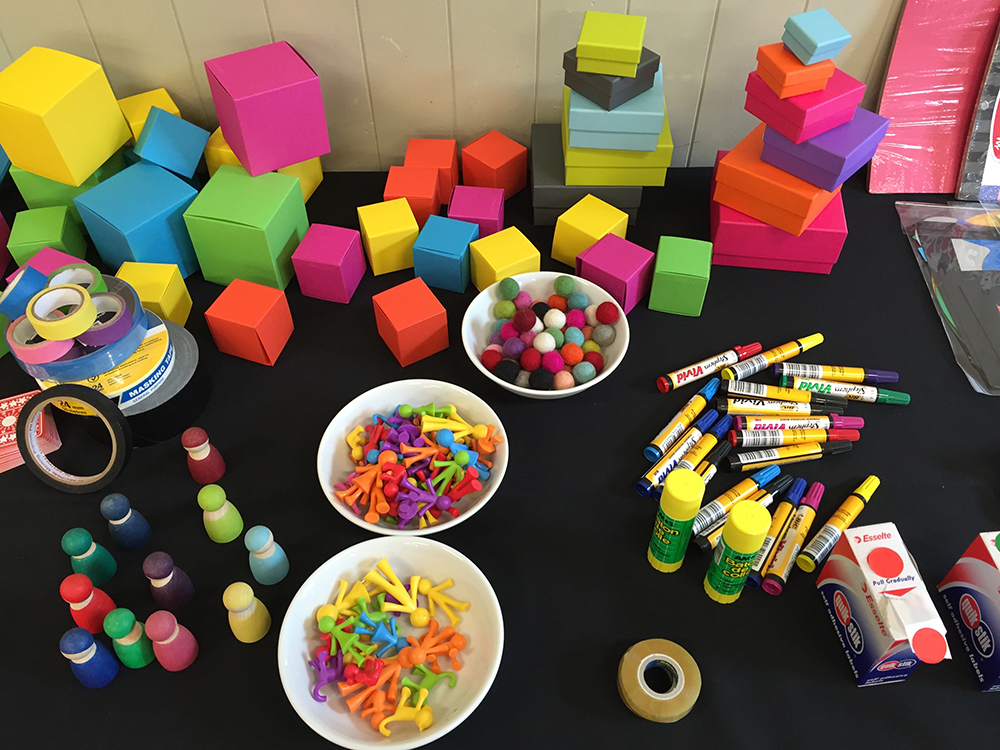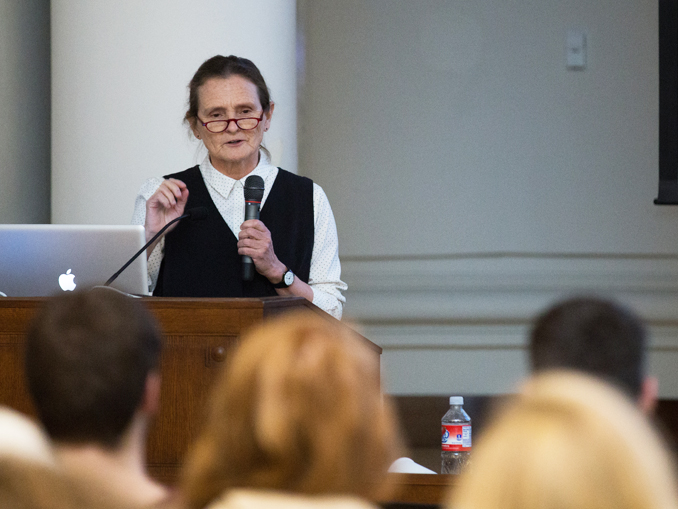
Liz Sanders is an experimental psychologist and a pioneer in generative design research. She is the founder of Make Tools, which leverages participatory human-centered methods for innovation and to address the big challenges we face in today’s world. Liz is also a professor within the design department at The Ohio State University. Kay recently spoke with Liz about her work in a field related to qualitative research that she helped to create.
Kay: What is generative design research?
Liz: With generative design research you are exploring what to design, whereas in more traditional design research you are exploring how to design something. It is design research that relates to the design and development process. Traditionally, you would begin with a request for a proposal and start with an idea, and then you would design and develop based on that idea. Generative design research is figuring out what needs to be designed. What do people really need? What would really make people’s lives better? For example, generative design research is going to start with a big open question about working families versus having a specific brief.
The client has a focus, and they have a product or a service that they offer. We start with that and then we get broader and broader and broader. Microsoft wanted us to explore the home PC experience and we said, well wait, at this time a lot of homes do not have PCs, let us explore the home experience.
Initially, it feels like you are exploring uncharted territory. You are wandering around aimlessly in a sea of information, knowledge, feelings, and thoughts. You approach it with a big-picture point of view. You have an idea of where you want to go, but you need to start big to find the edges of what to focus on.
So that was useful for understanding why some people have PCs, why some people do not, and how they use them. We always go one step bigger, and often two or three steps bigger, to start the exploration when we are doing generative design research.
Kay: Is generative design research participatory?
Liz: It does not have to be, but the approach that I’ve been using and that I write about is participatory—with the participation of the people who will be served with what’s being designed. Future users, the ultimate end-users, whoever is the recipient of what we are designing, are involved in the generative design research at the front end. We have the experts, including the marketers, the engineers, and the designers working with another set of experts who are authorities in the lived experience.
Kay: How do you learn from the experts in the lived experience?
Liz: I have a simple model of experience. When we are in the front end, we don’t know yet if we’re going to be identifying the need for a product, a service, a device, or whatever. What we’re doing is exploring the experiences of the people who will become the future users, and we need to really deeply understand their experiences, both their present experiences and their past experiences. Importantly, we need to give them an opportunity to imagine and express their future dreams for experience.
At first, you get people immersed in thinking about the current experience. What do you do? What do you think about it? Maybe we have them fill out a journal of their daily activities. Sometimes it’s an experience that they do every day, but one that they don’t necessarily think about, like using paper towels. We get them really focusing in on a question such as, “How am I using paper towels?” Then we may have them come together in a discussion where they share their thoughts and feelings.
We might explore their past experiences and after we have enabled them to think about current experiences and past experiences, we invite them to come up with new ideas—future ideas that make sense to them. You cannot just bring them to a table and say, “Imagine your future experience.” We prepare them by exploring their current and past experiences, and then we provide a lot of tools and materials in this future workshop situation. These tools and materials are carefully selected and tend to be a combination of visual and verbal components. Ultimately, they serve to inspire ideas or to provoke ideas. They also let people then express their ideas visually. I learned a long time ago that many adult respondents do not like to draw, but everybody has a good time moving pictures around on a big poster board and working with simple visual materials. Materials elicit or provoke ideas, and the materials help them express their thoughts for future experience. They’ll make a collage, or they’ll make a vision, and then they’ll share it with us.
Kay: So, you use a lot of collages. Are there other components of this toolbox?
Liz: Some of the components in the toolbox are two-dimensional including photos, paper shapes, and Post-it Notes. There are also three-dimensional components, which could include pipe cleaners, building blocks, LEGO© blocks, as well as some pieces that I’ve constructed for specific purposes to let people throw their ideas together quickly. The toolbox has an infinite number of possible toolboxes within it, because for every situation there may be two or three different toolkits that are used. The toolkits are customized for the focus of the project or for the people who are involved. For example, you would have a different toolkit for children than you would for the elderly. Lately, I have been using full-scale three-dimensional toolkits. In a hospital project, we had a full-scale hospital room covered with Velcro walls, and the components that went into a hospital room were available for hospital staff to reconfigure.

Kay: Was this to figure out their ideal workspace?
Liz: Exactly! The ideal hospital room from the point of view of the people who work there. They could do whatever they wanted, and they could position every single item down to the USB ports.
Kay: Do people go in to create this as a group or as individuals?
Liz: It depends. Usually, we will start with an individual kind of activity, where people might map something and then share it. If we are exploring past experience, which we might do as a first step, everybody has a different past experience so we might have participants do that individually. Then they share with each other. We’ve learned that sharing something they have made in that manner usually reveals quite a lot about them. Participants are free to talk about as much of it as they want. For example, they may discuss the choice of imagery and how things are put together. Also, we know that the mood with which people present tells us a whole lot. People learn about each other in deeper ways after they have shared something that they have made personally. After that, we find that we can ask people to collaborate, even with strangers. Of course, an hour before, they were strangers, but once they have been through this sharing experience of personal past experience, they can usually jump right into a future collaborative scenario.
Kay: So, this engenders trust?
Liz: Yes, and a little bit of vulnerability. People are free to expose as much as they want or as little as they want. Rarely do we have someone hold back on expressing. When we do, we just say, “Well, it’s fine if you don’t want to talk about that part of your collage.” But that rarely happens. People are usually more than happy to go on and on about it.
Kay: You say how generative design research tries to reach information outside of the person’s conscious awareness, from explicit, to tacit, to latent.
Liz: They have trouble putting it into words, but they can put it into pictures; and once they make the picture, they can usually find the word to share the picture with others. My definition of latent is knowledge that exists in the future, so it’s more the expression of dreams or future situations. This collaborative future-making is a way of bringing that out in people, so they will make images or collages or even hospital rooms that express their future.
Kay: Do they do this as a group or as individuals?
Liz: It depends on the topic. I would say we often start with individual and then end up with a group activity about the collaborative future. If it is something like insurance buying, we may or may not go to a group level. It depends on how we structured our group. It may not make sense to collaborate.
Kay: How do you choose participants for generative studies? Are there certain personality characteristics that you look for in people?
Liz: No. We tend not to exclude anyone, but we do give them homework. The homework is usually fairly intensive. It might be a workbook that they fill out or a photo journal that they make. The homework gets them thinking about the current situation and the past. We’ll start each session with the homework and if they show up and have not done their homework, they don’t get to participate. In short, if we are in an English-speaking situation and if they can speak English well enough to communicate and they are willing to take part in it, we do not exclude anyone.
Kay: How do you involve your client so they can absorb the insights?
Liz: The ideal situation is when the client codesigns the entire process with us. The best client is the one who gets involved in deciding how we are going to accomplish our objectives and what the toolkits are going to look like. The client comes in the field if we are going to conduct the sessions, say, in people’s homes. We have them hold the camera or audio recorder but they are not necessarily conducting the session. However, they can be present and will be involved in the analysis with us. When you are working with codesign, you really must take that mindset to the entire way of working. We don’t always get that much involvement; but ideally, they’re involved throughout the whole process so that when we’re done with the project, they feel a sense of ownership and can then implement the changes based on it.
Kay: How do you document the work so there is an institutional memory of what was learned?
Liz: It depends on the needs of the client. I would say we over-document everything. For example, we may use two video cameras plus an audio recorder. Everything is documented and stored. The level of analysis will depend on the client and the budget. We document usually more than we end up analyzing because you never know where the insights are going to come from. Some clients want all that documentation delivered in a usable form, and others do not.
Kay: The generative design researcher’s role is different. You are more of a facilitator.
Liz: It is a very different way of working. As businesspeople, we learned a long time ago that it does not make sense to go and find clients and talk them into this method. The best way is to do good work and have your clients tell others, and have people come to you because they are interested in approaching things with this mindset. It’s a different mindset that everybody’s an expert in their own way. Everybody is creative and we just need to let that happen. But if that is not your mindset, then it’s just a long process. I choose not to work with those kinds of clients.
Kay: What would be the best way to gain experience in these methods?
Liz: Do little pilot studies on your friends and family. Just start practicing and see how it feels. Some people just intuitively will fall into this and be good at it. If it’s awkward or you don’t really feel like people are the experts of their own experience and that they are creative, it’s going to take a lot longer. If so, maybe it’s not the right approach for you. If you are an intuitive, if you sort of get it, then you just start doing it, and you’ll find out. The language of the tools is very important, but that would be another talk!
Kay: Liz, it has been wonderful talking with you. Do you have anything else that you’d like to add?
Liz: If your audience is interested, have them send me a note of inquiry. I’m pretty accessible. I am an academic now, and I’d love to hear from interested people. My email is liz@maketools.com.
Resources for learning about Generative Design Research and how to apply it to your practice:
Convivial Toolbox: Generative Research for the Front End of Design, Liz Sanders & Pieter Jan Stappers, BIS Publishers, 2012
Papers, presentations, and other materials can be found on https://maketools.com.




Be the first to comment